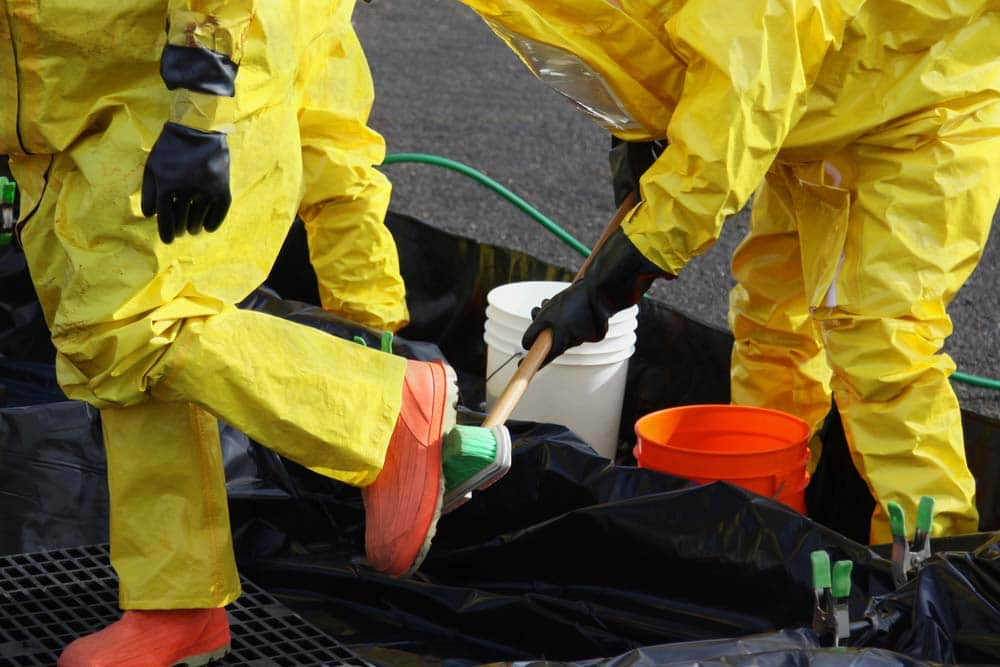HAZWOPER Decontamination Practices
HAZWOPER Decontamination Practices
HAZWOPER decontamination methods vary in their effectiveness for removing different substances. The effectiveness of any decontamination method should be assessed at the beginning of a program and periodically throughout the lifetime of the program. If contaminated materials are not being removed or are penetrating protective clothing, the decontamination program must be revised. The following methods may be useful in assessing the effectiveness of decontamination.

Visual Observation
For HAZWOPER sites, there is no reliable test to immediately determine how effective decontamination is. In some cases, effectiveness can be estimated by visual observation.
• Natural light. Discolorations, stains, corrosive effects, visible dirt, or alterations in clothing fabric may indicate that contaminants have not been removed. However, not all contaminants leave visible traces; many contaminants can permeate clothing and are not easily observed.
• Ultraviolet light. Certain contaminants, such as polycyclic aromatic hydrocarbons, which are common in many refined oils and solvent wastes, fluoresce and can be visually detected when exposed to ultraviolet light. Ultraviolet light can be used to observe contamination of skin, clothing, and equipment; however, certain areas of the skin may fluoresce naturally, thereby introducing an uncertainty into the test. In addition, use of ultraviolet light can increase the risk of skin cancer and eye damage; therefore, a qualified health professional should assess the benefits and risks associated with ultraviolet light prior to its use at a waste site.
Wipe Sampling
Wipe testing provides after-the-fact information on the effectiveness of decontamination. In this procedure, a dry or wet cloth, glass fiber filter paper, or swab is wiped over the surface of the potentially contaminated object and then analyzed in a laboratory. Both the inner and outer surfaces of protective clothing should be tested. Skin may also be tested using wipe samples.
Cleaning Solution Analysis
At HAZWOPER sites, another way to test the effectiveness of decontamination procedures is to analyze for contaminants left in the cleaning solutions. Elevated levels of contaminants in the final rinse solution may suggest that additional cleaning and rinsing are needed.
Testing for Permeation
Testing for the presence of permeated chemical contaminants requires that pieces of the protective garments be sent to a laboratory for analysis.
Health and Safety Hazards
While HAZWOPER decontamination is performed to protect health and safety, it can pose hazards under certain circumstances. Decontamination methods may:
- Be incompatible with the hazardous substances being removed (i.e., a decontamination method may react with contaminants to produce an explosion, heat, or toxic products).
- Be incompatible with the clothing or equipment being decontaminated (e.g., some organic solvents can permeate and/or degrade protective clothing).
- Pose a direct health hazard to workers (e.g., vapors from chemical decontamination solutions may be hazardous if inhaled, or they may be flammable). The chemical and physical compatibility of the decontamination solutions or other decontamination materials must be determined before they are used. Any decontamination method that permeates, degrades, damages, or otherwise impairs the safe functioning of the PPE is incompatible with such PPE and should not be used. If a decontamination method does pose a direct health hazard, measures must be taken to protect both decontamination personnel and the workers being decontaminated.
HAZWOPER Decontamination Facility Design
At a HAZWOPER site, decontamination facilities should be located in the Contamination Reduction Zone (CRZ), i.e., the area between the Exclusion Zone (the contaminated area) and the Support Zone (the clean area). The level and types of decontamination procedures required depend on several site-specific factors including:
- The chemical, physical, and toxicological properties of the wastes.
- The pathogenicity of infectious wastes.
- The amount, location, and containment of contaminants.
- The potential for, and location of, exposure based on assigned worker duties, activities, and functions.
- The potential for wastes to permeate, degrade, or penetrate materials used for personal protective clothing and equipment, vehicles, tools, buildings, and structures.
- The proximity of incompatible wastes.
- The movement of personnel and/or equipment among different zones.
- Emergencies.
- The methods available for protecting workers during decontamination.
- The impact of the decontamination process and compounds on worker safety and health.

